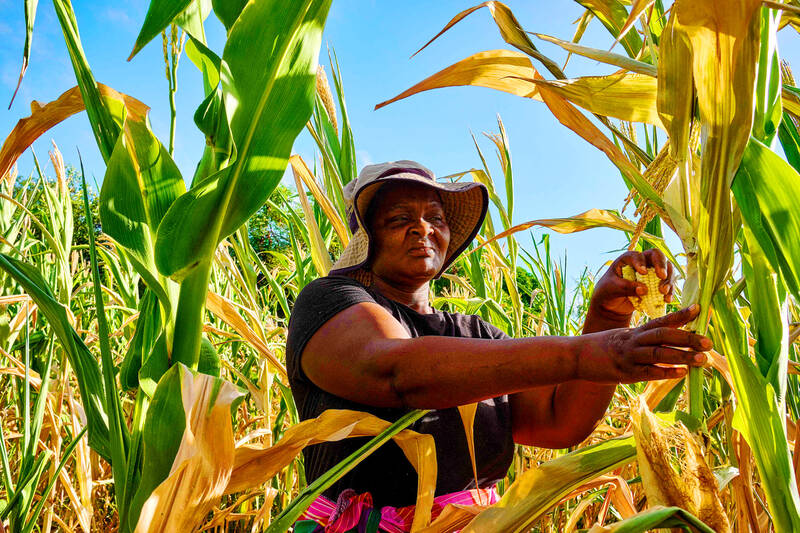Growing up in rural Nigeria, Adaeze Akpagbula spent her school years babysitting her family’s chicks through the night, adjusting the coal heater, food and water needed to keep the poultry, and the family income, alive.
Despite her best efforts, unpredictable temperatures, humidity and air quality changes led to the deaths of thousands of chicks, a lesson that would propel her to commit her life to making African farms more climate-resilient.
“Nigeria’s unprecedented rainfalls and weather patterns are not predictable, and with heat and cold stresses our birds were dying,” the 34-year-old agricultural engineer said in a telephone interview.

Photo: AFP
“We understand that innovation is pivotal to combating climate-related issues around food insecurity,” she said.
Akpagbula last year launched a remote-sensing device called PenKeep that monitors and controls environmental conditions in poultry farms. She is extending the technology into aquaculture and greenhouse farms.
Alongside container farms in South Africa cultivating soldier flies for animal feed, solar-powered fish and crop dryers in Tanzania and machine-learning pest detectors in Kenya, Africans are coming up with innovative solutions to overcome the effects of climate change on food production.
Such solutions are going to be needed as Africa is the continent most affected by hunger, a UN report says.
Together with conflict and economic crises, climate shocks are leaving Africa at the epicenter of a hunger crisis, with one in five — about 300 million people — short of food.
It is also the continent most vulnerable to climate shocks, while contributing the least to carbon emissions.
“Current societal inequalities, such as resource constraints, make it even more difficult to source funds to adapt to these changes,” said Mulako Kabisa, an environmental scientist at the Global Change Institute research platform at the University of the Witwatersrand, Johannesburg.
“Homegrown solutions matter because they take into cognizance the local context ... and what will be sustainable in the long run,” she said in e-mailed comments.
PenKeep’s solar-powered device interprets data from sensors that monitor environmental changes including temperature, water levels and air quality in poultry coops. Farmers are alerted of condition changes through a text message, e-mail or an alarm.
It is being used by more than 1,200 chicken farmers in western and northern Nigeria, with more than 100,000 chickens monitored in the company’s first six months.
Subscriptions of about US$15 a month make it more affordable for farmers, Akpagbula said.
Users can also use an artificial intelligence (AI) management app called FS Manager that provides farmers with information including management advice, weather updates and bookkeeping services.
“Nigeria has millions of poultry farmers ... but they are not producing enough ... because they are spending so much on energy and they have a lot of poultry mortality as a result of their environment,” Akpagbula said.
Farmers using PenKeep have seen poultry mortality rates decrease by 72 percent, Akpagbula said.
In east Africa, Tanzanian Evodius Rutta utilizes the continent’s abundance of sun through his MAVUNOLAB Solar Dryer that helps subsistence fish processors and farmers rapidly dry out produce including fish, fruits and vegetables, preventing postharvest food loss.
Small-scale fish processors at Lake Victoria in western Tanzania have begun using his dryer, reducing the drying time of 250kg of fish from 12 hours to four.
Climate variability has led to erratic rains that can spoil up to 50 percent of fishers’ harvests as they do not have access to cold storage, said Rutta, a sustainability researcher and MAVUNOLAB innovation hub founder.
“Because of the rains and high tides, it has also become very dangerous for fishermen that go to the sea and the lakes,” Rutta said in a telephone interview.
“We need low-cost solutions for farmers to adapt to changing climate patterns because it’s going to be unavoidable,” he said, adding that he was getting requests from farmers in Zimbabwe, Uganda and Kenya to use his invention.
Climate change can affect environmental factors such as temperature and humidity that can in turn influence the life cycle and spread of crop pests, the UN Food and Agriculture Organization says.
Pests are already responsible for at least 40 percent of crop loss worldwide.
Kenyan computer scientist Esther Kimani witnessed this firsthand growing up when pests devastated up to one-third of her family’s pea, potato and corn crops in the south of Kenya.
By the time the pests were detected, the destruction was so severe that even using pesticides became pointless.
Kimani was inspired to invent the Early Crop Pest and Disease Detection Device — a solar-powered tool that uses AI and machine learning-enabled cameras to rapidly detect and alert farmers of pests and diseases.
Kimani’s invention is being used by more than 5,000 farmers across Kenya since its launch in 2020. A group-leasing model reduces the cost to each farmer to US$3 per month.
The device also advises farmers about which pesticides to use when, according to predicted climatic changes.
Kimani said that more than 1,214 hectares of land have been protected from pest infestation by her invention.
She recently won the Royal Academy of Engineering’s Africa Prize for Engineering Innovation, for which Akpagbula and Rutta were also short-listed.
Some homegrown innovations are also focusing on protecting agricultural output while reducing carbon emissions.
South Africa’s Philafeed helps build tailor-made black soldier fly container farms. The fly larvae feed on food waste, diverting planet-heating methane emissions from landfills.
The larvae can also be used as a protein feed for livestock, reducing the need for carbon-intensive soya and fish meal.
The larvae manure, a byproduct known as frass, helps increase soil and plant tolerance against drought and flooding, and in turn can increase crop yield in times of climate uncertainty.
“Through black soldier flies we want farmers to be able to diversify their income if there is a failed season due to climate change,” Philafeed cofounder Maya Zaken said.
Philafeed is piloting its new container model in Cape Town.
Despite initial funding challenges and struggles to get farmer buy-in, Akpagbula has faith that her innovation, alongside others on the continent, would soon become essential to farmers as climate shocks become more severe and more frequent.
“People always say why now? Why you doing this now?” Akpagbula said. “I tell them it’s because of the urgency of the climate crisis.”

Taiwan’s rapidly aging population is fueling a sharp increase in homes occupied solely by elderly people, a trend that is reshaping the nation’s housing market and social fabric, real-estate brokers said yesterday. About 850,000 residences were occupied by elderly people in the first quarter, including 655,000 that housed only one resident, the Ministry of the Interior said. The figures have nearly doubled from a decade earlier, Great Home Realty Co (大家房屋) said, as people aged 65 and older now make up 20.8 percent of the population. “The so-called silver tsunami represents more than just a demographic shift — it could fundamentally redefine the

The US government on Wednesday sanctioned more than two dozen companies in China, Turkey and the United Arab Emirates, including offshoots of a US chip firm, accusing the businesses of providing illicit support to Iran’s military or proxies. The US Department of Commerce included two subsidiaries of US-based chip distributor Arrow Electronics Inc (艾睿電子) on its so-called entity list published on the federal register for facilitating purchases by Iran’s proxies of US tech. Arrow spokesman John Hourigan said that the subsidiaries have been operating in full compliance with US export control regulations and his company is discussing with the US Bureau of

Businesses across the global semiconductor supply chain are bracing themselves for disruptions from an escalating trade war, after China imposed curbs on rare earth mineral exports and the US responded with additional tariffs and restrictions on software sales to the Asian nation. China’s restrictions, the most targeted move yet to limit supplies of rare earth materials, represent the first major attempt by Beijing to exercise long-arm jurisdiction over foreign companies to target the semiconductor industry, threatening to stall the chips powering the artificial intelligence (AI) boom. They prompted US President Donald Trump on Friday to announce that he would impose an additional

China Airlines Ltd (CAL, 中華航空) said it expects peak season effects in the fourth quarter to continue to boost demand for passenger flights and cargo services, after reporting its second-highest-ever September sales on Monday. The carrier said it posted NT$15.88 billion (US$517 million) in consolidated sales last month, trailing only September last year’s NT$16.01 billion. Last month, CAL generated NT$8.77 billion from its passenger flights and NT$5.37 billion from cargo services, it said. In the first nine months of this year, the carrier posted NT$154.93 billion in cumulative sales, up 2.62 percent from a year earlier, marking the second-highest level for the January-September